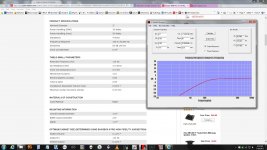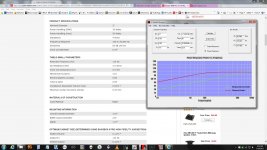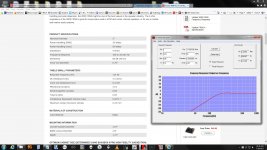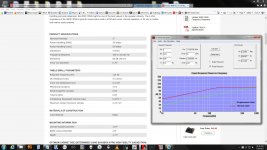Hello all,
I have an amp that can output 7 watts per channel into a 4 ohm load per channel.
I have this on each channel.
Visaton FRS8-4 3.3" Full-Range Speaker 4 Ohm
The sound quality is great at low to mid volumes. Once I reach a high volume the lower tones, even upper tones get distorted greatly.
Its as soon as I exceed a certain level, the distortion instantly occurs.
I was wondering, is this due to me driving my amp too hard and not giving the drivers enough power?
If so, would getting more efficient drivers be better?
Here is the amp
TDA1515BQ datasheet - 24 W BTL or 2 X 12 W Stereo Car Radio Power Amplifier
Thanks!
I have an amp that can output 7 watts per channel into a 4 ohm load per channel.
I have this on each channel.
Visaton FRS8-4 3.3" Full-Range Speaker 4 Ohm
The sound quality is great at low to mid volumes. Once I reach a high volume the lower tones, even upper tones get distorted greatly.
Its as soon as I exceed a certain level, the distortion instantly occurs.
I was wondering, is this due to me driving my amp too hard and not giving the drivers enough power?
If so, would getting more efficient drivers be better?
Here is the amp
TDA1515BQ datasheet - 24 W BTL or 2 X 12 W Stereo Car Radio Power Amplifier
Thanks!
My best guess is that both amp and speaker are at fault. From the speaker specs: Resonant Frequency (Fs) 115 Hz - Sensitivity82 dB 1W/1m - Maximum Linear Excursion (Xmax) 0.25 mm. That driver is a really poor choice for a full range application, it probably should be high passed above 200Hz. And due to it's poor efficiency, the amp is probably being pushed too hard to drive it any higher than moderate levels. I'm not at all surprised your getting poor sound quality at high levels.
Mike
Mike
Using a driver with better sensitivity (dB/1watt) will mean the amplifier doesn't get stressed as hard for a given system volume and therefore will produce less distortion. The FRS8-4 is already reasonable in this respect, at least for a 3" speaker.What kind of specs am I looking for in a good full range driver suited for this amp?
Xmax is the measure of how far the voicecoil can move from resting position before it's travel becomes non-linear (distorted). Low (bass) frequencies require significant excursion of the voice coil and since music is usually dominated in amplitude by the bass, xmax can become a significant factor in how loud a full range speaker can be played before audible distortion occurs due to the voicecoil operating outside of the linear range of motion.
Unfortunately, having a high xmax spec doesn't automatically gaurantee low distortion, and not every manufacturer follows the same standard as to how it should be measured. Having a low xmax spec is almost always reason for concern however.
Even the best 3" drivers with impressive excursion capabilites can't produce full range sound at very high levels. Practical solutions would be to use a physically larger fullrange driver (4-8") which offers both higher sensitivity and lower excursion needed for a given system volume, or have larger driver(s) handle the bass while the 3" drivers only handle ~300Hz up where excursion is not a problem for them.
If using a physically larger driver isn't possible, I would suggest maybe the Tymphany/Vifa TG9FD10-04 or TC9FD18-08. They are a little bit more sensitive and have much better excursion capability than the Visatons.
Last edited:
Hmm, looks like it has ~5.5 W/stereo/4 ohms at low distortion or ~7.4 dB dynamic headroom, so subtract this from whatever the highest SPL peaks you want to listen at and that's how efficient the speaker system needs to be.
For example, if this is a desktop system where you're sitting < ~ 1 m/3 ft away, then worst case would normally be ~ 85 dB avg./105 dB peaks, so the system needs to be at least 97.6 dB/m.
In short, you'll either need a large speaker system or only listen to highly compressed recordings to lower efficiency requirements down to < ~92 dB/m.
GM
For example, if this is a desktop system where you're sitting < ~ 1 m/3 ft away, then worst case would normally be ~ 85 dB avg./105 dB peaks, so the system needs to be at least 97.6 dB/m.
In short, you'll either need a large speaker system or only listen to highly compressed recordings to lower efficiency requirements down to < ~92 dB/m.
GM
Something that has to considered with class D amps is that they have very little distortion with increasing volume up to a point. Then they distort very badly almost instantly. It's an all or nothing thing. A lot of class D amps are rated at 10% THD. That is already more than the usable power available. The real usable power is something like 75% of that. It the amp is rated at 1% THD, consider that as an absolute max power rating.
Bob
Bob
The same can be said for almost all types of solid state amps... The op's amp is classB/AB anyway, not classD.Something that has to considered with class D amps is that they have very little distortion with increasing volume up to a point. Then they distort very badly almost instantly. It's an all or nothing thing.
Tymphany TG9FD-10-04 3-1/2" Glass Fiber Cone Full Range
If I use these drivers with a greater x max, wouldn't it still be distorted bcause of the higher excursion?
If I use these drivers with a greater x max, wouldn't it still be distorted bcause of the higher excursion?
If I use these drivers with a greater x max, wouldn't it still be distorted bcause of the higher excursion?
Yes, and why I omitted any excursion adjustment to the efficiency required for wide BW driver apps since frequency modulation distortion [FMD] becomes an issue.
GM
How about these. Specs seem good.
Peerless 830985 2-1/2" Full Range Woofer
Again, look at the driver's base efficiency at 1 kHz and assume that's all it's good for, so for high SPL using just small wide BW [FR] drivers, they need large front and back [compound] horn loading, so keep them semi manageable in size they need good, solid corner loading. That, or build an 'infinite' line array with lots of them to get efficiency up.
GM
A single 3.3" will distort at distances further than 1' (least to my ears).
I don't care how much clean power you have on tap.
Harmonic distortion increases with loudness (putting in 100hz and seeing 200hz, 300hz, 400hz, etc).
Frequency modulation distortion (lower notes making the voice gargle) is another enemy that makes your driver distort.
Gm is right, you can horn load them (that helps) and/or limit frequency response for more output.
I've been down this road before and am finally getting somewhere.
Norman
I don't care how much clean power you have on tap.
Harmonic distortion increases with loudness (putting in 100hz and seeing 200hz, 300hz, 400hz, etc).
Frequency modulation distortion (lower notes making the voice gargle) is another enemy that makes your driver distort.
Gm is right, you can horn load them (that helps) and/or limit frequency response for more output.
I've been down this road before and am finally getting somewhere.
Norman
Last edited:
I have one Visaton FRS8-4 3.3" Full-Range Speaker 4 Ohm connected to each channel of the stereo circuit of this amplifier TDA1515BQ datasheet - 24 W BTL or 2 X 12 W Stereo Car Radio Power Amplifier
I am getting what I am assuming is clipping at id say about above 70% of the max volume.
******************
Please respond with A, B, C, or D (or combination) and a reason/explanation if youd like.
For answer b/c, please use a number or combination of numbers.
******************
Should I.......
A-make another amp that can provide more rms output power
B-get a better driver with 1. Higher excurion, 2. Higher efficiency, 3. Lower rms rating, 4. Higher rms rating
C-wire the amp in mono (bridged) mode and wire the drivers in 1. Series, 2. Parallel.
Thanks so much!
Ps, I know this is weird, but I dont want to get into offtopic conversations about why this is such a bad setup in the first place and how I should change my whole design. (Trying to avoid those responses)
Any help is appreciated.
I am getting what I am assuming is clipping at id say about above 70% of the max volume.
******************
Please respond with A, B, C, or D (or combination) and a reason/explanation if youd like.
For answer b/c, please use a number or combination of numbers.
******************
Should I.......
A-make another amp that can provide more rms output power
B-get a better driver with 1. Higher excurion, 2. Higher efficiency, 3. Lower rms rating, 4. Higher rms rating
C-wire the amp in mono (bridged) mode and wire the drivers in 1. Series, 2. Parallel.
Thanks so much!
Ps, I know this is weird, but I dont want to get into offtopic conversations about why this is such a bad setup in the first place and how I should change my whole design. (Trying to avoid those responses)
Any help is appreciated.
A. Get a bigger amp. 12w/ch should be adequate for general listening at moderate levels. It will not provide party levels. You need some overhead in any case. I like to see at least 20dB of overhead. This will, of course depend on the sensitivity of your speakers.
B.
1. Get a bigger driver -- 5-6" class for a start. You want lower excursion, ideally 0 excursion at max SPL. The larger the driver, the lower the excursion at any given power level. In general, larger drivers will have ....
2.Higher efficiency.
3-4. Irrelevant. As long as the "music power" rating is adequate for the SPL levels you require, you are good. More speakers are blown up by too small amps then too big amps. Unless you are trying to do heavy metal at concert levels. Then you need your speakers to match RMS power with required SPL.
Apparently you do not want to hear this, but your entire system is too small for the SPL levels you require. The distortion that you are hearing could be any of a number of things, all of which are cured by a larger system.
1. You may be clipping the amp. If the distortion comes on suddenly with a minor twist of the volume knob, likely.
2. I know nothing about your driver. You may be driving the coil out of the gap, you may be banging the coil against the back plate. In any case, you are encountering Doppler/IM/phase distortion (pick you own expert's terminology). This is basically why single-driver speakers don't do rock. Get a bigger, more efficient driver. Do a FAST system.
Bob
C.
B.
1. Get a bigger driver -- 5-6" class for a start. You want lower excursion, ideally 0 excursion at max SPL. The larger the driver, the lower the excursion at any given power level. In general, larger drivers will have ....
2.Higher efficiency.
3-4. Irrelevant. As long as the "music power" rating is adequate for the SPL levels you require, you are good. More speakers are blown up by too small amps then too big amps. Unless you are trying to do heavy metal at concert levels. Then you need your speakers to match RMS power with required SPL.
Apparently you do not want to hear this, but your entire system is too small for the SPL levels you require. The distortion that you are hearing could be any of a number of things, all of which are cured by a larger system.
1. You may be clipping the amp. If the distortion comes on suddenly with a minor twist of the volume knob, likely.
2. I know nothing about your driver. You may be driving the coil out of the gap, you may be banging the coil against the back plate. In any case, you are encountering Doppler/IM/phase distortion (pick you own expert's terminology). This is basically why single-driver speakers don't do rock. Get a bigger, more efficient driver. Do a FAST system.
Bob
C.
I have one Visaton FRS8-4 3.3" Full-Range Speaker 4 Ohm connected to each channel of the stereo circuit of this amplifier TDA1515BQ datasheet - 24 W BTL or 2 X 12 W Stereo Car Radio Power Amplifier
I am getting what I am assuming is clipping at id say about above 70% of the max volume.
******************
Please respond with A, B, C, or D (or combination) and a reason/explanation if youd like.
For answer b/c, please use a number or combination of numbers.
******************
Should I.......
A-make another amp that can provide more rms output power
B-get a better driver with 1. Higher excurion, 2. Higher efficiency, 3. Lower rms rating, 4. Higher rms rating
C-wire the amp in mono (bridged) mode and wire the drivers in 1. Series, 2. Parallel.
Thanks so much!
Ps, I know this is weird, but I dont want to get into offtopic conversations about why this is such a bad setup in the first place and how I should change my whole design. (Trying to avoid those responses)
Any help is appreciated.
OK, first, I'll address your final comments;
Sadly, you DO need to change your whole setup if you expect to have a system give you full range sound at high output levels, the underlying physics will always prevail. Trying to avoid these responses will get you nowhere.Ps, I know this is weird, but I don't want to get into off topic conversations about why this is such a bad setup in the first place and how I should change my whole design. (Trying to avoid those responses) Any help is appreciated.
As I stated earlier, that Visaton driver is not really a legitimate full ranger and the graphics below show you why it's not.




The first two are with the driver in a box sized to give flattest frequency response. Number two shows the basic problem. The thermal limit sets maximum SPL is down to about 102 dB at any frequency, it's displacement limit is on a steady downward slope, and where it crosses the thermal limit at 900 Hz is where the distortion begins to rise, at 100 Hz it's SPL down to about 65 dB. The next two graphics show the driver in a smaller box giving a two dB hump around 250 Hz which will give it a "boxy" sound.
So your only options are to put it into a horn enclosure as others have said, or get a physically larger driver capable of higher output and with higher sensitivity ( at least 87 dB 1W/1M or higher) and live with the inevitable limited high frequency response, or move on to a multi-way system.
You would also benefit from a higher power amp.
Sometimes the truth hurts, but reality is what it is.
Mike
Last edited:
Another voice in the chorus: pretty much all the answers to your now and future questions have been given.
Even the most diehard full- range driver aficionados among us acknowledge the basic laws of physics ( well, most of the time 😉 ).
If you want to achieve higher SPL than you are currently getting, both more dynamic headroom in the amp ( at least several times the maximum power level) and / or drivers with higher sensitivity and / or power handling will be required.
It's quite possible to get very satisfying sound with moderately sized Fr drivers, but you may need to adjust your expectations to the reality of what's achievable
Even the most diehard full- range driver aficionados among us acknowledge the basic laws of physics ( well, most of the time 😉 ).
If you want to achieve higher SPL than you are currently getting, both more dynamic headroom in the amp ( at least several times the maximum power level) and / or drivers with higher sensitivity and / or power handling will be required.
It's quite possible to get very satisfying sound with moderately sized Fr drivers, but you may need to adjust your expectations to the reality of what's achievable
'Physics, it's the LAW': How Much Amplifier Power Do I Need? | Crown Audio - Professional Power Amplifiers
GM
GM
- Status
- Not open for further replies.
- Home
- Loudspeakers
- Full Range
- Distortion at high volumes